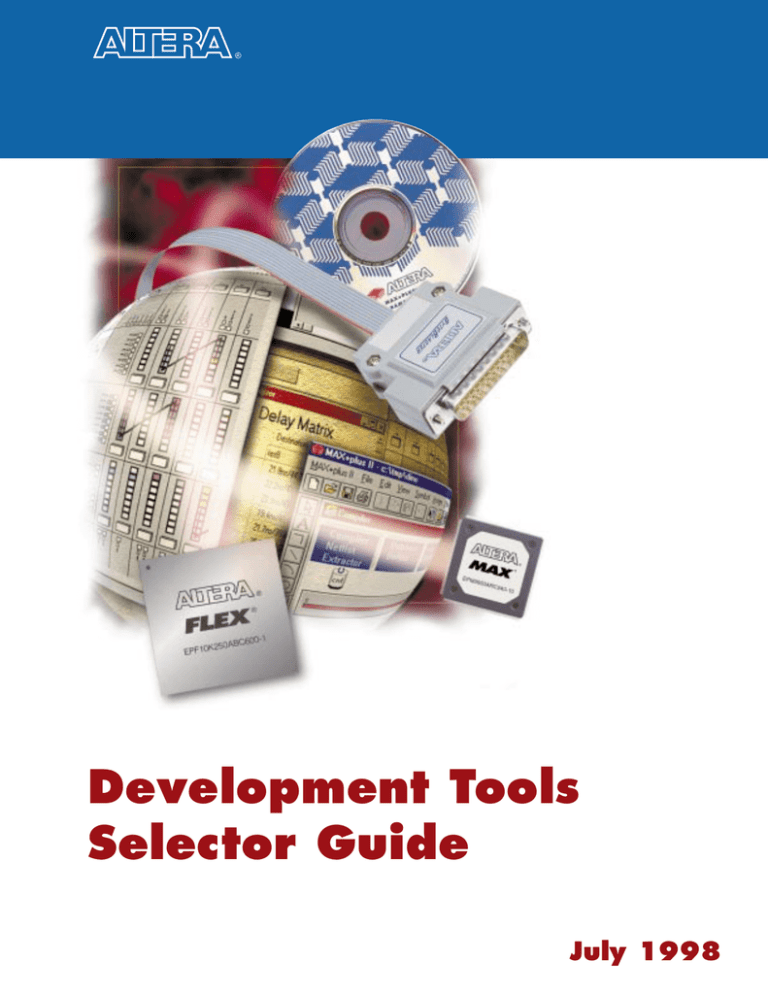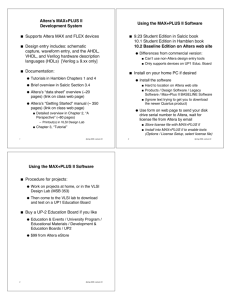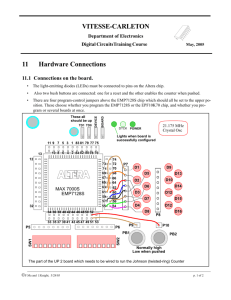
®
Development Tools
Selector Guide
July 1998
Introducing Altera Programmable Logic Development Tools
Altera offers the fastest, most powerful, and most flexible
programmable logic development software and programming hardware in the industry. The Altera MAX+PLUS® II
development tools provide a broad range of features with
an easy-to-use graphical user interface. The MAX+PLUS II
software also offers interfaces to industry-standard EDA
tools that allow easy integration with your chosen design
environment.
Altera development tools include the following features:
■
Interfaces to EDA tools that utilize EDIF 2 0 0 and
3 0 0 netlists, the library of parameterized modules
(LPM), Standard Delay Format Files (.sdf),
Verilog HDL, and VHDL.
Choosing the Right Tools for You
This development tools selector guide will help you
choose the Altera MAX+PLUS II design environment that
best meets your needs. The MAX+PLUS II design
environment consists of the following elements:
■
Support for multiple device architectures, including
the Altera FLEX® 10K, FLEX 6000, FLEX 8000,
MAX® 9000, MAX 7000, MAX 5000, and Classic™
programmable logic device (PLD) families.
■
■
■
■
Design site and migration products
MegaCore™ functions
Maintenance support
Programming hardware
■
Multi-platform support, including Microsoft
Windows 95 and 98, and Windows NT for PCs, as well
as X-Windows for Sun SPARCstation, HP 9000 Series
700/800, and IBM RISC System/6000 workstations.
At the end of this guide, you will find a list of
recommended system configurations for all platforms
supported by the MAX+PLUS II software, as well as
descriptions of Altera’s Commitment to Cooperative
Engineering Solutions (ACCESS ) program, Altera
Megafunction Partners Program (AMPP ) alliance, and
Altera Consultants Alliance Program (ACAP ).
SM
■
Support for hardware description languages, including
the VHDL 1987 and 1993 standards, Verilog HDL, and
the Altera Hardware Description Language (AHDL).
SM
SM
Step 1 – Select a Design Site & Migration Products
You can configure your MAX+PLUS II development
environment to suit your needs by combining a design
site with migration product(s).
Device Architectures
Your Altera design environment begins with a design
site, which is identified with a PLS ordering code prefix
(e.g., PLS-BASE). The design site offers the basic features
and device support for designing with Altera PLDs.
You can obtain additional device support and features by
ordering migration products, which are identified with a
PLSM ordering code prefix (e.g., PLSM-10K). Migration
products allow you to customize your MAX+PLUS II
design environment by adding features to your design
site. You can add migration products to your system at
any time as your design needs change or expand.
Your choice of design site and migration products are
determined by the following criteria:
■
Device Architecture Support
Altera supports the following device architectures:
FLEX
10 K
FLEX
6000
FLEX
8000
M A X
9000
M A X
7000
Classic +
The specific devices supported by each architecture
are shown in the following table:
Page 2
Devices Supported
FLEX 10K
FLEX 10K, FLEX 10KE, FLEX 10KA
FLEX 6000
FLEX 6000, FLEX 6000A
FLEX 8000
FLEX 8000A
MAX 9000
MAX 9000, MAX 9000A
MAX 7000
MAX 7000, MAX 7000S, MAX 7000A
Classic+Plus
Classic and MAX 5000 families,
EPF6010A, EPF6016, EPF6016A,
EPF8282A, EPF8452A, EPM9320,
EPM9320A, EPF10K10, and
EPF10K10A devices
For detailed information on Altera devices, refer to
the Altera Component Selector Guide, the current
Altera data book, or the Altera world-wide web site at
http://www.altera.com.
■
Software Features
MAX+PLUS II offers a wide variety of design entry,
compilation, verification, programming, and other software features.
The Altera MAX+PLUS II Development Tools selection
matrix on the following page shows which devices and
software features are offered with each Altera product.
From the matrix, choose one design site and as many
migration products as you need for your design.
Altera Corporation
Altera MAX+PLUS II Development Tools
Other
Device
Programming
Design Verification
Design Compilation
Design Entry
Device Support
Devices & Features
Supported:
UNIX Workstation
PLSBAS
E
PLSMAG
N
PLS- UM
NET
/
PLSM PC
-AD
E
PLSM
-9K
PLSM
-6K/
8
PLSM K
-10K
Meg
aCo
re F
unct
PLSWS/ ions*
SN
PLSWS/
H
PLS- P
WS/
I
Meg BMRS
aCo
re F
unct
ions
*
PC
Notes
*
See page 4 for a complete list of MegaCore migration products.
Blue-shaded areas represent design sites (indicated by a PLS prefix).
Unshaded areas represent migration products (PLSM prefix).
FLEX 10K
High-density, high-performance device family featuring embedded array blocks (EABs).
FLEX 6000
Low-cost, high-performance alternative to gate arrays.
FLEX 8000
High-performance Flexible Logic Element MatriX (FLEX) architecture device family.
MAX 9000
High-density Multiple Array MatriX (MAX) architecture device family.
MAX 7000
Second-generation MAX architecture that supports in-system programmability (ISP).
Classic+Plus
For specific devices supported, refer to the device architecture support table on page 2.
Schematic Design Entry
The Graphic Editor and Symbol Editor provide basic building blocks for creating a design,
including the library of parametrized modules (LPM), TTL, and custom functions.
Text-Based Design Entry:
AHDL and VHDL or Verilog HDL
MAX+PLUS II supports a high-level design methodology based on a variety of HDLs, including
the Altera Hardware Description Language (AHDL), VHDL, and Verilog HDL.
Waveform Design Entry
The Waveform Editor is used to specify logic by entering input and output waveforms.
EDA Interfaces
The bidirectional EDIF interface and the VHDL and Verilog HDL netlist writers allow designers to
import and export design files between MAX+PLUS II and industry-standard EDA tools.
Floorplan Editing
The Floorplan Editor provides a graphical method for assigning logic cells and pins.
Hierarchical Design
Management
The Hierarchy Display allows you to easily traverse hierarchical designs.
Library of Parametrized
Modules (LPM)
The LPM offers parametrized functions that can be used as building blocks to simplify design
entry.
MegaCore Functions
MegaCore functions are pre-verified HDL design files for complex, system-level functions that are
created by Altera and optimized for Altera device architectures.
Timing-Driven
Synthesis & Fitting
Timing-driven synthesis & fitting allows you to specify timing constraints for any portion of the
design, thereby controlling MAX+PLUS II synthesis and fitting.
Logic Synthesis & Fitting
Logic synthesis & fitting ensures optimal device utilization by automatically matching design
requirements with device resources, eliminating manual routing.
Automatic Error Location
The Message Processor quickly locates and highlights syntax and logic errors in all design
editors for swift design debugging.
Design-Rule Checking
The Design Doctor checks designs with customizable design rules and flags potentially unreliable
circuitry.
Multi-Device Partitioning
Multi-device partitioning automatically divides large designs into two or more devices from the
same family.
OpenCore™ Evaluation
OpenCore evaluation enables designers to compile and simulate MegaCore and AMPP functions
before licensing the function.
Timing Analysis
The Timing Analyzer traces all possible signal paths to determine the speed-critical and
performance-limiting paths of a design.
Waveform Editing
The Waveform Editor allows designers to create a file containing the input waveforms that drive
simulation and the node names to be simulated, and then view the simulation results.
Functional Simulation
The Simulator uses design information to model the logical function of a design with zero
propagation delays.
Timing Simulation
The Simulator tests the logical function and worst-case timing of a fully synthesized and
optimized design to a resolution of 0.1 ns.
Multi-Device Simulation
The Simulator allows designs partitioned into multiple devices to be simulated together.
Device Programming
Together with the appropriate programming hardware, the MAX+PLUS II software programs,
configures, verifies, examines, blank-checks, and functionally tests Altera devices on your
desktop. It supports in-system programmability (ISP), in-circuit reconfigurability (ICR), and
traditional programming methods.
Jam™ Programming and
Test Language
MAX+PLUS II software supports the Jam programming and test language, which is an interpreted
language optimized for programming devices via the IEEE 1149.1 standard JTAG interface.
Floating Node Capability
Floating node capability allows multiple users to share a single design site over a network.
On-Line Help
MAX+PLUS II Help provides complete documentation for MAX+PLUS II features, design
guidelines, and detailed device information. It is also available in Japanese.
ES Site License
The ES Site License entitles you to install an unlimited number of MAX+PLUS II design sites
with an entry-level feature set.
Altera Corporation
Page 3
Step 2 – Add MegaCore Migration Products
As PLDs reach higher density levels,
design flows must be as efficient as possible. Altera addresses this need by being
the industry leader in providing reusable
and synthesizable megafunctions—called
MegaCore functions—that are targeted
for popular PLD applications.
MegaCore
TM
MegaCore functions are developed, pre-tested, documented and licensed by Altera as MAX+PLUS II migration
products. These functions are optimized for specific
Altera device architectures, and allow you to rapidly
implement the functions you need rather than building
them from the ground up.
Altera’s MegaCore functions support applications such as
PCI and other bus interfaces, digital signal processing
(DSP), and communications. The table below lists the
functions available today.
Altera expands and updates its MegaCore function
offerings regularly. For the latest information on
MegaCore functions, go to the Altera world-wide web
site at http://www.altera.com.
instantiate, compile, and simulate your designs to verify
that a function fits your design needs. Once you evaluate
a MegaCore function, you can license it and receive the
authorization code, which enables the MAX+PLUS II
software to generate programming files, as well as EDIF,
VHDL, or Verilog HDL netlist files for simulation in
third-party EDA tools.
Download MegaCore Functions at No Cost
Designers can download MegaCore functions for
OpenCore evaluation from the Altera world-wide web
site at http://www.altera.com. The following figure
shows the typical MegaCore function design flow:
Design Flow for Using MegaCore Functions
Download the MegaCore function from the
Altera WWW site (http://www.altera.com).
Use the OpenCore feature in MAX+PLUS II to instantiate
the MegaCore function. Then compile and simulate the design.
Decide if the function meets
the design requirements.
Altera OpenCore Feature
The Altera OpenCore evaluation feature,
available with all MAX+PLUS II developOpenCore
ment tools, offers designers with a
no-risk means of evaluating MegaCore
and AMPP functions. The OpenCore feature allows you to
License the MegaCore function from Altera
and obtain the authorization codes.
TM
Program the device and/or generate an output file
for simulation in a third-party environment.
Altera MegaCore Functions
APPLICATIONS
ORDERING CODE
FUNCTION
PCI Master-Target Interface
PLSM-PCI/A
PCI master-target interface with internal DMA engine and zero-wait state
burst mode operation at 33 MHz
PCI Target Interface
PLSM-PCIT1
PCI target interface with zero-wait state burst mode operation of unlimited
length at 33 MHz
DSP/Fast
Fourier Transform
PLSM-FFT
Fully parameterized fast Fourier transform function
Microperipheral
Functions
PLSM-MICROLIB
PLSM-8237
PLSM-8251
Library of UART, DMA controller, and parallel port controller functions
Programmable DMA controller
Programmable communications interface
PLSM-8255
Programmable peripheral interface adapter
PLSM-6402
PLSM-16450
PLSM-6850
Universal asynchronous receiver/transmitter
Universal asynchronous receiver/transmitter
Asynchronous communications interface adapter
PLSM-8259
Programmable interrupt controller
Video/Color Space
Converter
PLSM-CSC
RGB-to-YCrCb and YCrCb-to-RGB color space converters
Communications/
Error Checking
PLSM-CRC
Fully parameterized cyclic redundancy code generator and checker
Page 4
Altera Corporation
Step 3 – Add Software Maintenance
Altera enhances and improves its development tools regularly. The software maintenance program ensures that you
receive the newest version of the MAX+PLUS II development software every quarter, which will help you expand
your Altera development system and automatically benefit from Altera’s ongoing product developments.
The Altera software maintenance program provides the following benefits:
■
New Device Support
Altera remains at the forefront of PLD development, offering the highest density and highest performance devices
in the industry. Altera regularly expands its device and package options, which allows you to design your system
with the most advanced devices and packages.
■
New Software Features
Altera’s innovation involves all aspects of PLD technology, including design methodology. New software features
and enhancements make the MAX+PLUS II software easier to use and improve design compilation times. Users
with maintenance agreements receive new features with each MAX+PLUS II update, ranging from HDL synthesis—
which is now provided as a standard feature—to improved timing-driven compilation performance.
■
Programming Methodology
Altera is committed to incorporating the latest programming methods, including in-system programmability (ISP),
in-circuit reconfigurability (ICR), and the Jam programming and test language. Altera continues to enhance its
programming hardware and software to make these programming methods easily accessible.
■
Third-Party EDA Interfaces
The MAX+PLUS II software provides interfaces to all major EDA design tools as a standard feature. These
interfaces allow you to work in the design environment you know best and implement your design in the Altera
device family you choose. Altera continually enhances the MAX+PLUS II design environment to stay current with
third-party EDA tool improvements and upgrades.
Maintenance Ordering Method
Use the following table to select the appropriate maintenance product for your MAX+PLUS II software. Identify your
platform and MAX+PLUS II system configuration, and then choose the corresponding maintenance product (e.g., if
you own PLS-BASE and one migration product, your maintenance product is PLAESW-BASE).
MAX+PLUS II Maintenance Products
Platform
System Configuration
Design Site
PC
UNIX
Workstation
No. of Migration Products*
Maintenance
Product
PLS-BASE
1
PLAESW-BASE
PLS-BASE
2 or More
PLAESW-PC
PLS-MAGNUM
–
PLAESW-PC
PLS-NET/PC
–
PLAESW-FLOAT
PLS-WS/SN
–
PLAESW-FLOAT
PLS-WS/HP
–
PLAESW-FLOAT
PLS-WS/IBMRS
–
PLAESW-FLOAT
* MegaCore function migration products do not count toward the number of migration products used to determine the appropriate
maintenance product.
Altera Corporation
Page 5
Step 4 – Select the Appropriate Programming Hardware
Altera’s ByteBlasterMV™ Parallel Download Cable and
BitBlaster™ Serial Download Cable (PL-BYTEBLASTERMV
and PL-BITBLASTER) are available for in-circuit reconfiguration of FLEX 10K, FLEX 8000, and FLEX 6000
devices, and in-system programming of MAX 9000 and
MAX 7000 devices. These cables download device data
from the MAX+PLUS II software or directly from a
system prompt.
hardware and software needed for programming all
Altera devices. PL-ASAP2 includes an LP6 Logic
Programmer card for Windows-based PC and compatible
computers, a Master Programming Unit (MPU), and
programming software.
Use the following table to select the appropriate programming adapters for your devices; adapters for new
devices are available when the devices are introduced.
The Altera Stand-Alone Programmer (PL-ASAP2), used
with the appropriate programming adapters, provides the
DEVICE(S)
EPC1064 (1)
EPC1064V (1)
EPC1441 (2)
EPC1 (2)
EPC1213 (2)
EPM9320
EPM9320A
EPM9400
EPM9480
EPM9560
EPM9560A
EPM7032
EPM7032V
EPM7032S
EPM7032AE
EPM7064
EPM7064S
EPM7064AE
EPM7096
EPM7128
EPM7128E
EPM7128A
(1)
(2)
(3)
(4)
PACKAGE
ADAPTER
DIP, J-Lead
TQFP
PLMJ1213
PLMT1064
DIP
J-Lead
J-Lead (84-pin)
RQFP (208-pin)
PGA (280-pin)
J-Lead (84-pin)
RQFP (208-pin)
J-Lead (84-pin)
RQFP (208-pin)
RQFP (240-pin)
RQFP (208-pin)
RQFP (240-pin)
RQFP (208-pin)
RQFP (240-pin)
PGA (280-pin)
RQFP (304-pin)
RQFP (208-pin)
RQFP (240-pin)
J-Lead (44-pin)
PQFP (44-pin)
TQFP (44-pin)
J-Lead (44-pin)
TQFP (44-pin)
J-Lead (44-pin)
TQFP (44-pin)
J-Lead (68-pin)
J-Lead (84-pin)
PQFP (100-pin)
J-Lead (44-pin)
J-Lead (84-pin)
TQFP (44-pin)
TQFP (100-pin)
J-Lead (68-pin)
J-Lead (84-pin)
PQFP (100-pin)
J-Lead (84-pin)
PQFP (100-pin)
PQFP (160-pin)
J-Lead (84-pin)
TQFP (100-pin)
TQFP (144-pin)
PLMJ1213
PLMJ1213
PLMJ9320-84
PLMR9000-208
PLMG9000-280
PLMJ9320-84
PLMR9000-208NC (3)
PLMJ9400-84
PLMR9000-208
PLMR9000-240
PLMR9000-208
PLMR9000-240
PLMR9000-208
PLMR9000-240
PLMG9000-280
PLMR9000-304
PLMR9000-208NC (3)
PLMR9000-240NC (3)
PLMJ7000-44
PLMQ7000-44
PLMT7000-44
PLMJ7000-44
PLMT7000-44
PLMJ7000-44
PLMT7000-44
PLMJ7000-68
PLMJ7000-84
PLMQ7000-100
PLMJ7000-44
PLMJ7000-84
PLMT7000-44
PLMT7000-100NC (3)
PLMJ7000-68
PLMJ7000-84
PLMQ7000-100
PLMJ7000-84
PLMQ7000-100
PLMQ7128/7160-160
PLMJ7000-84
PLMT7000-100NC (3)
PLMT7000-144NC (3)
DEVICE(S)
EPM7128S
EPM7160E
EPM7160S
EPM7192E
EPM7192S
EPM7256E
EPM7256A
EPM7256S
EPM7384AE
EPM7512AE
EPM5032
EPM5064
EPM5128
EPM5130
EPM5192
EP1810
EP610
EP910
PACKAGE
ADAPTER
J-Lead (84-pin)
PQFP (100-pin)
TQFP (100-pin)
PQFP (160-pin)
J-Lead (84-pin)
PQFP (100-pin)
PQFP (160-pin)
J-Lead (84-pin)
PQFP (100-pin)
PQFP (160-pin)
PGA (160-pin)
PQFP (160-pin)
PQFP (160-pin)
PQFP (160-pin)
PGA (192-pin)
PQFP (208-pin)
RQFP (208-pin)
PQFP (208-pin)
RQFP (208-pin)
TQFP (144-pin)
PQFP (208-pin)
TQFP (144-pin)
PQFP (208-pin)
DIP
J-Lead
SOIC
J-Lead
J-Lead
PGA
J-Lead
PGA
PQFP
J-Lead
PGA
DIP
J-Lead
SOIC
DIP
J-Lead
J-Lead
PGA
PLMJ7000-84
PLMQ7000-100NC (3)
PLMT7000-100NC (3)
PLMQ7128/160-160NC (3)
PLMJ7000-84
PLMQ7000-100
PLMQ7128/7160-160
PLMJ7000-84
PLMQ7000-100NC (3)
PLMQ7128/160-160NC (3)
PLMG7192-160
PLMQ7192/7256-160
PLMQ7192/256-160NC (3)
PLMQ7192/7256-160
PLMG7256-192
PLMR7256-208
PLMR7256-208
PLMR7256-208NC (3)
PLMR7256-208NC (3)
PLMT7000-144NC (3)
PLMR7256-208NC (3)
PLMT7000-144NC (3)
PLMR7256-208NC (3)
PLMD5032A
PLMJ5032A
PLMS5032A
PLMJ5064A
PLMJ5128A
PLMG5128A
PLMJ5130A
PLMG5130A
PLMQ5130A
PLMJ5192A
PLMG5192A
PLED1810
PLEJ1810 (4)
PLES610 (4)
PLED610 (4)
PLEJ610 (4)
PLEJ910 (4)
PLEG910 (4)
FLEX 8000 Configuration EPROM.
FLEX 10K, FLEX 8000, or FLEX 6000 Configuration EPROM.
These devices are not shipped in carriers.
Any device that requires a programming adapter identified with a PLE ordering code prefix also requires a PLAD3-12 compatibility adapter.
Page 6
Altera Corporation
ES Site License & PLS-WEB Design Site
Altera offers the ES Site License program, which entitles
your company to install an unlimited number of
MAX+PLUS II design sites with an entry-level feature set.
You will receive the ES Site License once you purchase a
PC-based version of the MAX+PLUS II design site.
Altera also offers the PLS-WEB design site, which is an
entry-level version of the MAX+PLUS II software. You
can download PLS-WEB for free from the Altera worldwide web site at http://www.altera.com.
To take advantage of the Altera ES Site License or the
PLS-WEB design site, you must first register and obtain a
software authorization code from the Altera world-wide
web site.
The ES Site License and PLS-WEB design site support
MAX 7000 and Classic+Plus devices, as well as the
following features:
■
■
■
■
■
■
■
■
■
■
■
Schematic and AHDL design entry
Library of parameterized modules (LPM)
OpenCore evaluation
EDA interfaces
Floorplan editing
Hierarchical design management
Logic synthesis and fitting
Automatic error location
Timing analysis
Device programming
On-line help
Recommended System Configurations
The following chart shows the recommended standard system configurations for using the Altera development
software tools listed in this guide.
Recommended System Configurations
Memory Requirements
Device
Family
Minimum
Available Memory
(Mbytes)
Minimum
Physical RAM
(Mbytes)
FLEX 10K
FLEX 6000
FLEX 8000
MAX 9000
MAX 7000
256
64
64
64
48
128
32
32
32
16
Windows-Based PC
■ Pentium-based PC or compatible computer
■ Operating system software:
– Microsoft Windows NT version 3.51 or higher
or
– Microsoft Windows 95 or Windows 98
■ SVGA graphics card and monitor compatible with
Microsoft Windows
■ CD-ROM drive
■ 2- or 3-button mouse compatible with Microsoft Windows
■ Full-length 8-bit ISA slot for programming card
■ Parallel port
■ HTML browser (e.g., Netscape Navigator)
Altera Corporation
Sun SPARCstation
■ Sun SPARCstation with color or monochrome monitor
■ Sun Solaris version 2.5 or higher
■ ISO 9660-compatible CD-ROM drive
■ HTML browser (e.g., Netscape Navigator)
HP 9000 Series 700/800 Workstation
■ HP 9000 Series 700/800 workstation with color or
monochrome monitor
■ HP-UX version 10.20 or higher
■ HP-CDE
■ ISO 9660-compatible CD-ROM drive
■ HTML browser (e.g., Netscape Navigator)
IBM RISC System/6000 Workstation
■ IBM RISC System/6000 workstation with color or
monochrome monitor
■ AIX version 4.1 or higher
■ ISO 9660-compatible CD-ROM drive
■ HTML browser (e.g., Netscape Navigator)
Page 7
ACCESS Program & Partners
Altera’s Commitment to Cooperative Engineering
Solutions (ACCESS) program includes EDA vendors
who have developed design entry, synthesis, verification,
and/or device programming products that support
Altera’s programmable logic device families. Through this
program, Altera supports the industry-standard EDA tools
common to many of today’s design environments.
Altera is continually evaluating and adding new ACCESS
partners to benefit customers.
Interfaces to Synopsys, Cadence, Synplicity, Exemplar,
Viewlogic, and Mentor Graphics tools are provided on all
MAX+PLUS II CD-ROMs. Contact Altera about interfaces
to other ACCESS partner tools.
ACCESS Partners & Supported Tools
CADENCE
• Composer
• Concept
• Leapfrog
• NC-Verilog
• Synergy
• Verilog-XL
EXEMPLAR LOGIC
• Galileo Extreme
• Leonardo Spectrum
MENTOR GRAPHICS
• Design Architect
• FPGA Station
• PLDSynthesis
• QuickSim II
• Quick VHDL
• QuickHDL Pro
SYNOPSYS
• Design Compiler
• DesignWare
• FPGA Compiler
• FPGA Express
• Motive
• SmartModels
(Logic Modeling
Group)
• VCS
• VHDL Compiler
• VHDL System
Simulator (VSS)
SYNPLICITY
• HDL Analyst
• Synplify
VIEWLOGIC
• IntelliFlow
• Motive
• SpeedWave
• Vantage VHDL
• VCS
• WorkView
Office
OTHER ACCESS PARTNERS
• Accel Technologies • Model Technology
• ACEO Technology
• OrCAD
• Acugen Software
• Simucad
• Aldec
• Sophia Systems
• Flynn Systems
and Technology
• IKOS Systems
• Summit Design
• i-Logix
• Veda Design
• ISDATA
Automation
• Logical Devices
• VeriBest
• Mentor Graphics
• Vista Technologies
• MINC
ACCESS SM PROGRAM
Altera Megafunction
Partners Program
SM
Altera has developed the Altera Megafunction Partners
Program (AMPP) alliance to provide a broad portfolio of
Altera-optimized megafunctions that facilitate highdensity design. AMPP partners are highly trained on
Altera’s tools and device architectures to help ensure
that their products meet our customers’ needs. AMPP
megafunctions range from simple building-block logic
to very complex system-level cores, such as
Reed-Solomon CODECs.
Altera Offices
Corporate Headquarters
Altera Corporation
101 Innovation Drive
San Jose, CA 95134
USA
Telephone: (408) 544-7000
http://www.altera.com
Altera European Headquarters
Altera U.K. Limited
Holmers Farm Way
High Wycombe
Buckinghamshire
HP12 4XF
United Kingdom
Telephone: (44) 1 494 602 000
Altera Consultants
Alliance Program
The Altera Consultants Alliance Program (ACAP) is
designed to provide expert design assistance to Altera
PLD users and help them quickly get their products to
market. ACAP consultants are highly trained on Altera
devices and tools; Altera carefully selects each ACAP
consultant based on their knowledge of Altera devices,
tools, and their design background. By recruiting a
diverse group of consultants, Altera offers a group of
experts who can help designers accelerate their design
cycle times.
Altera Japan Limited
Shinjuku Mitsui Building 36F
1-1, Nishi-Shinjuku, 2 Chome
Shinjuku-ku, Tokyo 163-04
Japan
Telephone: (81) 3 3340 9480
http://www.altera.com/japan
Altera International Limited
Suite 908-920, Tower 1
Metroplaza
223 Hing Fong Road
Kwai Fong, New Territories
Hong Kong
Telephone: (852) 2487 2030
Copyright © 1998 Altera Corporation. Altera, ACAP, AMPP, ACCESS, BitBlaster, ByteBlasterMV, Classic, FLEX, FLEX 10K, FLEX 10KA, FLEX 10KE, FLEX 6000,
FLEX 6000A, FLEX 8000, FLEX 8000A, Jam, MAX, MAX 5000, MAX 7000, MAX 7000A, MAX 7000E, MAX 7000S, MAX 9000, MAX 9000A, MAX+PLUS,
MAX+PLUS II, MegaCore, OpenCore, The Altera Advantage, and specific device and development tool part numbers are trademarks and/or service marks of Altera
Corporation. Other brands or products are trademarks of their respective holders. The specifications contained herein are subject to change without notice. All rights
reserved.
M-SG-TOOLS-12




